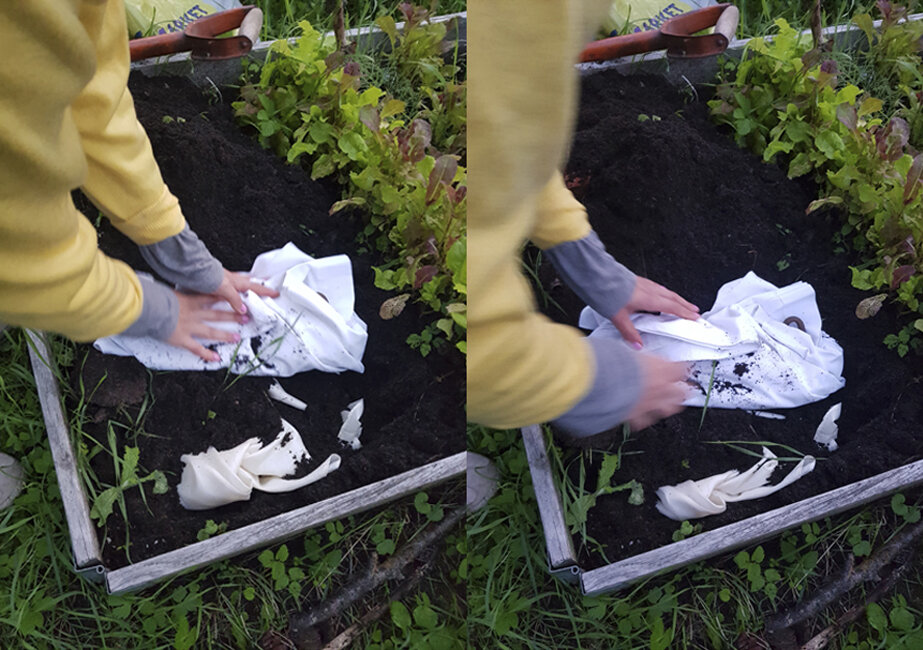Sometimes you should just bury a garment in the groud and enjoy that feeling, 2020.
Installation included: Two dresses made out of an old cotton sheet(the other one has been buried for a one year), “Pyhävaatteita” stones and branches to mark the burying spot, clothes to be buried, photographs of the burying spots, form for documenting the burying process.
Visitors were invited to take a garment from this installation and bury it.
Mekot 190202, 190204 ja 190206 eli lyhyt tutkielma tekstiilien hautaamisesta, 2019. Installaatio koostui kolmesta puuvillamekosta, jotka olivat olleet haudattuina maahan kaksi, neljä ja kuusi kuukautta.
Dresses 190202, 190204 and 190206, a short study on burying textiles, 2020. Installation included three cotton dresses that were buried for two, four and six months.
2018
In the past, getting new clothes was rare, time-consuming and a special occasion. Home sewing was common and for many people the only affordable way to get new garments. Nowadays nearly everyone is able to buy as many clothes, as often as they want to. Home sewing has changed into an act against mass produced garments. People sew because they want to, not because they have to. Through my own sewing practice I am investigating when and how designing happens while making clothes. Do I even have to design or could I just make clothes?
Making garments is complicated. Pattern making is about millimeters. Converting a two-dimensional pattern into a three-dimensional garment requires skill and a well-trained methods. Making clothes is a challenging handicraft, partly because self-made clothes should not look too crafty.
In this project, I focused on sewing clothes instead of designing them. Through my own sewing practice I tried to observe when and how designing happens while sewing garments. Can home made garment be a quality product? Should home sewer try to produce same quality as factories and experienced professionals?
Home sewing is not only about the quality of the outcome, that is the garment, but the quality of the whole process. Sewing is a hobby, a meaningful way to spend time which improves the quality of life.
I sewed eight dresses with a pattern that I chose from a sewing book. I chose the pattern, selected materials and modified the pattern. Sewing felt liberating. I stitched dresses and improvised if something did not go just as it should.
When the sixth dress was done I came across with a small crisis. These are just dresses, not me. I have not designed these. I don’t sense a great emotional connection with the dresses, even though I have made them. What is the value of this dresses to me? I wore some of the dresses for a few times to observe their use value and to see if my user experience is somehow different when wearing a self-made garment.
While I was thinking about the quality and value of the garments, I decided to bury some of the dresses in the ground. What does burying do to the quality and value of the garment? Does the quality of making increase with burying?
I ended up burying the clothes partly because I got fed up, partly as a statement and partly because it’s just exciting to bury things. I got tired of sewing, I got bored with fashion, I got tired of designing and thinking about the nature of design. I wanted to speak out for creative craftsmanship. There is no need to make neat stitches and sew straight, sometimes you should just bury the garment in the ground and enjoy that feeling. Designer does not always have to have a great purpose for ones work, sometimes you can just bury the garment in the ground and enjoy that feeling.
Burying is a symbolic gesture that twists the prevailing perceptions of making clothes. It extends traditional sewing practice and brings the coincidence into clothing making. Everyone knows how to bury a garment and can do so if they want.
The project was created in the frame of the HIAP Design Residency 2018, “Arranging Practice: Proximity, Distance, Instance.” A production of the Helsinki International Artist Programme HIAP in cooperation with the British Council, Design Museum, Helsinki Design Week and Aalto University.
Program curator: Martin Born







